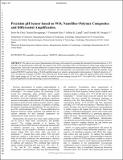| dc.contributor.author | Choi, Seonjin | |
| dc.contributor.author | Savagatrup, Suchol | |
| dc.contributor.author | Kim, Yoonseob | |
| dc.contributor.author | Lang, Jeffrey H | |
| dc.contributor.author | Swager, Timothy M | |
| dc.date.accessioned | 2020-10-21T22:30:06Z | |
| dc.date.available | 2020-10-21T22:30:06Z | |
| dc.date.issued | 2019-10 | |
| dc.date.submitted | 2019-08 | |
| dc.identifier.issn | 2379-3694 | |
| dc.identifier.issn | 2379-3694 | |
| dc.identifier.uri | https://hdl.handle.net/1721.1/128142 | |
| dc.description.abstract | . We report a new type of potentiometric pH sensor with sensitivity exceeding the theoretical Nernstian behavior (-59.1 mV/pH). For the pH-sensitive electrode, 1D tungsten oxide (WO3) nanofibers (NFs) were prepared to obtain large surface area and high porosity. These NFs were then stabilized in a reactive porous chloromethylated triptycene poly(ether sulfone) (Cl-TPES) binder, to facilitate proton diffusion into the polymer membrane. The measurements were performed with a differential amplifier using matched MOSFETs and providing a 10-fold amplified signal over a simple potentiometric determination. A high pH sensitivity of -377.5 mV/pH and a linearity of 0.9847 were achieved over the pH range of 6.90-8.94. Improved signal-to-noise ratios with large EMF signal changes of 175 mV were obtained in artificial seawater ranging pH 8.07-7.64 (ΔpH = 0.43), which demonstrates a practical application for pH monitoring in ocean environments. | en_US |
| dc.language.iso | en | |
| dc.publisher | American Chemical Society (ACS) | en_US |
| dc.relation.isversionof | http://dx.doi.org/10.1021/acssensors.9b01579 | en_US |
| dc.rights | Article is made available in accordance with the publisher's policy and may be subject to US copyright law. Please refer to the publisher's site for terms of use. | en_US |
| dc.source | Prof. Swager via Ye Li | en_US |
| dc.title | Precision pH Sensor Based on WO3 Nanofiber-Polymer Composites and Differential Amplification | en_US |
| dc.type | Article | en_US |
| dc.identifier.citation | Choi, Seon-Jin et al. "Precision pH Sensor Based on WO3 Nanofiber-Polymer Composites and Differential Amplification." ACS Sensors 4, 10 (October 2019): 2593–2598 © 2019 American Chemical Society | en_US |
| dc.contributor.department | Massachusetts Institute of Technology. Department of Chemistry | en_US |
| dc.contributor.department | Massachusetts Institute of Technology. Institute for Soldier Nanotechnologies | en_US |
| dc.contributor.department | Massachusetts Institute of Technology. Department of Electrical Engineering and Computer Science | en_US |
| dc.relation.journal | ACS Sensors | en_US |
| dc.eprint.version | Author's final manuscript | en_US |
| dc.type.uri | http://purl.org/eprint/type/JournalArticle | en_US |
| eprint.status | http://purl.org/eprint/status/PeerReviewed | en_US |
| dc.date.updated | 2020-10-07T18:26:34Z | |
| dspace.orderedauthors | Choi, S-J; Savagatrup, S; Kim, Y; Lang, JH; Swager, TM | en_US |
| dspace.date.submission | 2020-10-07T18:26:39Z | |
| mit.journal.volume | 4 | en_US |
| mit.journal.issue | 10 | en_US |
| mit.license | PUBLISHER_POLICY | |
| mit.metadata.status | Complete | |
